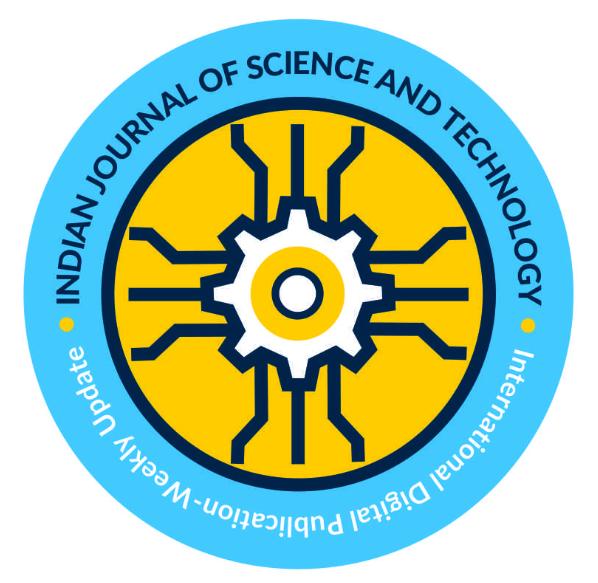INDIANJOURNALOFSCIENCEANDTECHNOLOGY

RESEARCHARTICLE
OPENACCESS
Received: 22.12.2020 Accepted: 02.02.2021 Published: 16.02.2021


Received: 22.12.2020 Accepted: 02.02.2021 Published: 16.02.2021
GUpenderReddy1∗,TSivaNageswaraRao2,NSrinivasaRao3 , VVenkateswaraRao4
1 AssistantProfessor,DepartmentofMathematics,NizamCollege(A),OsmaniaUniversity, Hyderabad,500001,TS,India
2 AssociateProfessor,DivisionofMathematics,DepartmentofS&H,V.F.S.T.R(Deemedto beUniversity),Vadlamudi,522207,Guntur(Dt.),A.P,India
3 AssistantProfessor,DivisionofMathematics,DepartmentofS&H,V.F.S.T.R(Deemedtobe University),Vadlamudi,522207,Guntur(Dt.),A.P,India
4 ResearchScholar,DivisionofMathematics,DepartmentofS&H,V.F.S.T.R(Deemedtobe University),Vadlamudi,522207,Guntur(Dt.),A.P,India
Citation: ReddyGU,RaoTSN, RaoNS,RaoVV(2021)Bipolarsingle valuedneutrosophicdetour distance.IndianJournalofScience andTechnology14(5):427-431. http s://doi.org/10.17485/IJST/v14i5.2102
∗
Correspondingauthor yuviganga@gmail.com
Funding: None
CompetingInterests: None
Copyright: ©2021Reddyetal.This isanopenaccessarticledistributed underthetermsofthe Creative CommonsAttributionLicense,which permitsunrestricteduse, distribution,andreproductionin anymedium,providedtheoriginal authorandsourcearecredited.
PublishedByIndianSocietyfor EducationandEnvironment(iSee)
ISSN Print:0974-6846 Electronic:0974-5645
Objectives: Inthepresentarticle,wededucedacharacterizationofBipolar SingleValuedNeutrosophic(BSVN)radiusandeccentricityofthevertex basedonBipolarSingleValuedNeutrosophicset(BSVNS)detour. Method: WeobtainedsomedefinitionsBSVNonavertexlikeBSVNdetoureccentric vertex,BSVNdetourradius,BSVNdetourdiameter,BSVNdetourcentered andBSVNdetourperiphery. Findings: Wederivedsomeimportantresults basedontheseBSVNdetourradius,diameter,centerandperiphery. Novelty: ThedetourdistanceoftheBSVNSmodelisproposedandgeneralizedby this.AnimportantandsuitableconditionforthegraphsoftheSingleValued NeutrosophicSet(SVNS)modeltoBSVNSdetourdistanceshasbeenidentified. Keywords: Detourdistance;BSVNdetoureccentric;BSVNdetourdistance; BSVNdetourperipheralnode;BSVNdetourpath

TheNeutrosophicsets(1) isagreatexactimplementforthesituationuncertaintyinthe realworld.Theseuncertaintyideascomefromthetheoriesoffuzzysets(2),intuitionistic fuzzysets(3) andinterval-valuedintuitionisticfuzzysets(4).Therepresentationofthe neutrosophicsetsistruth,indeterminacyandfalsityvalue.TheseT,I,Fvaluesbelong tostandardornonstandardunitintervaldenotedby]-0,1+[.
TheideaofasubclassoftheNSandSVNSbyintuitionisticfuzzysets(5),inthisthe functionsTruth,Indeterminacy,Falsityarenotdependentandthesevaluesarepresent within[0,1].NeutrosophictheoryiswidelyexpandedinallfieldsespeciallyinGraph theoryandTopology.
Inagraphtheory,thenewgraphmodelwasinvitedbyusingBSVNsetisknownas BSVNGraph(BSVNG)(6,7).TheideaofBSVNgraphsfromthefuzzy,bipolarfuzzyand single-valuedneutrosophicgraphs.Theuncertaintyonthegraphofverticesandedges orbothrepresentationstobeafuzzygraph.
Inthismanuscript,wediscussaboutBSVNgraphsandneutrosophicdetourdistancebetweentwoverticesofthegraphbased onBSVNeccentricity,radius,diameter,andtheperipherywithrespecttodetourdistance.
Explanation2.1:BSVNsets ABSVNsetisexplainedasthemembershipfunctionsrepresentedasanobjectin W isdenotedby {< w, T P , IP , FP , T N , IN , FN >: w εW } thefunctions T P , IP , FParemappingfrom W to [0, 1] and T N , IN , FN are mappingfrom W to [ 1, 0]. Example.LetW = {w1, w2, w3} and A = {< w1, 0.4, 0.2, 0.6, 0.03, 0.2, 0.01 >,< w2, 0.6, 0.4, 0.2, 0.5, 0.3, 0.03 >, < w3, 0 7, 0 04, 0 3, 0 8, 0 4, 0 05 >}isaBSVNsetin W
Explanation2.2:SVNrelationon W :Let W beanon-emptyset.Thenwecallmapping Z =( W, T p , I p , FP , T N , IN , FN ), FN (w) : WXW → [ 1, 0 ] X [0, 1] isa BSVN relationon W suchthat T P Z (w1, w2) ε[0, 1], IP Z (w1, w2) ε[0, 1], FP Z (w1, w2) ε[0, 1] and T N Z (w1, w2) ε[ 1, 0], IN Z (w1, w2) ε[ 1, 0], FN Z (w1, w2) ε[ 1, 0]
Explanation2.3:Let Z1 =(T P z1 , IP z1 , FP z1 , T N z1 , IN z1 , FN z1 ) and Z2 =(T P z2 , IP z2 , FP z2 , T N z2 , IN z2 , FN z2 ) beaBSVNgraphsona set W .If Z2 isaBSVNrelationon Z1,then T P Z2 (w1, w2) ≤ min(T P Z1 (w1) , T P Z1 (w2)), IP Z2 (w1, w2) ≥ max(IP Z1 (w1) , IP Z1 (w2)), FP Z2 (w1, w2) ≥ max(FP Z1 (w1) , FP Z1 (w2)) and T N Z2 (w1, w2) ≥ max(T N Z1 (w1) , T N Z1 (w2)), IP Z2 (w1, w2) ≤ min(IN Z1 (w1) , IN Z1 (w2)), FN Z2 (w1, w2) ≤ min(FN Z1 (w1) , FN Z1 (w2))for all w1, w2 ∈ W
Explanation2.4: Thesymmetricpropertydefinedon BSVN relation Z on W isexplainedby T P Z (w1, w2)= T P Z (w2, w1), IP Z (w1, w2)= IP Z (w2, w1), FP Z (w1, w2)= FP Z (w2, w1) and T N Z (w1, w2)= T N Z (w2, w1), IN Z (w1, w2)= IN Z (w2, w1), FN Z (w1, w2)= FN Z (w2, w1) forall w1, w2 ∈ W
Explanation2.5:BSVNgraph
ThenewgraphinSVNisdenotedbyforall w1, w2 ∈ W , G∗ =(V, E) isapair G =(Z1, Z2),where Z1 = (T P z1 , IP z1 , FP z1 , T N z1 , IN z1 , FN z1 ) isaBSVNSin V and Z2 =(T P z2 , IP z2 , FP z2 , T N z2 , IN z2 , FN z2 ) isBSVNSin V 2 definedas T P Z2 (w1, w2) ≤ min(T P Z1 (w1) , T P Z1 (w2)), IP Z2 (w1, w2) ≥ max(IP Z1 (w1) , IP Z1 (w2)), FP Z2 (w1, w2) ≥ max(FP Z1 (w1) , FP Z1 (w2)) and T N Z2 (w1, w2) ≥ max(T N Z1 (w1) , T N Z1 (w2)), IP Z2 (w1, w2) ≤ min(IN Z1 (w1) , IN Z1 (w2)), FN Z2 (w1, w2) ≤ min(FN Z1 (w1) , FN Z1 (w2))for all w1, w2 ∈ W TheBSVNSGofanedgedenotedby w1w2 ∈ V 2
Explanation2.6 Let G =(Z1, Z2) beaBSVNSGanda, b ∈ V .Apath P : a = w0, w1, w2,..., wk 1, wk = b in G isasequenceofdistinctverticessuchthat T P Z2 (wi 1, wi) > 0, IP Z2 (wi 1, wi) > 0, FP Z2 (wi 1, wi) > 0, T N Z2 (wi 1, wi) > 0, IN Z2 (wi 1, wi) > 0, FN Z2 (wi 1, wi) > 0 where i = 1, 2, 3,..., k andlengthofthepathis k ∈ N(apositiveinteger), where a is calledinitialvertexand b iscalledterminalvertexinthepath.
Explanation2.7. ABSVNgraph G =(Z1, Z2) of G∗ =(V, E) iscalledastrongBSVNgraphif T P Z2 (w1, w2)= min(T P Z1 (w
If P : a = w0, w1, w2,..., wk 1, wk = b beapathoflength k between a and b then (T P Z2 (a, b) , IP Z2 (a, b) , FP Z2 (a, b))k and (T N Z2 (a, b) , IN Z2 (a, b) , FN Z2 (a, b))k isdefinedas
(T N Z2 (a, b), IN Z2 (a, b), FN Z2 (a, b))k =
(T P Z2 (a, b) , IP Z2 (a, b) , FP Z2 (a, b))∞ and (T N Z2 (a, b) , IN Z2 (a, b) , FN Z2 (a, b))∞ issaidtobethestrengthofconnectednessbetween twovertices x and y inG,where (T P Z2 (a, b), IP Z2 (a, b), FP Z2 (a, b))∞ = (sup{T P Z2 (a, b)} , inf {T P Z2 (a, b)} , inf {FP z2 (a, b)}) (T N Z2 (a, b), IN Z2 (a, b), FN Z2 (a, b))∞ = (in f {T N Z2 (a, b)} , sup{T N Z2 (a, b)} , sup{FN z2 (a, b)}) If (T P Z2 (a, b) ≥ (T P Z2 (a, b))∞ , IP Z2 (a, b) ≤ (IP Z2 (a, b))∞ , FP Z2 (a, b) ≤ (FP Z2 (a, b))∞) and (T N Z2 (a, b) ≥ (T N Z2 (a, b))∞ , IN Z2 (a, b) ≤ (IN Z2 (a, b))∞ , FN Z2 (a, b) ≤ (FN Z2 (a, b))∞) thenthearc ab inGiscalleda strongarc.Apatha-bisastrongpathifallarcsonthepatharestrong.
3BSVNdetourdistance
BSVNdetourdistanceisdefinedasthelengthof a b.Thestrongpathbetween a and b isifthereisnootherpathlonger thanPbetween a and b andwedenotethisbyBSND(a, b).Anya-bstrongpathwhoselengthisBSND (a, b) iscalled an a b BSVNdetourpath.Theeccentricity(EccBND(G))ofanodeisthedistancefromanodetothefurthestnodeinthe bipolarsingle-valuedneutrosophicgraphG.Theradius(radBNG(G)) ofabipolarsingle-valuedneutrosophicgraphGisthe minimumamongalleccentricityofnodes.Theperipheryofthegraphistheeccentricityequaltothediameterofthepath.The diameter(diamBND(G))ofabipolarsinglevaluedneutrosophicgraphGisthemaximumamongalleccentricityofnodes.
4BSVNdetourperiphery(PerBND (G))andBSVNdetoureccentricgraph(EccBND (G))
Proof. SupposeGisaBSVNdetourself-centeredBSVNgraphandletbbeanodeinG. Let a ∈ b∗ BND.So EccBND (b)= BNDG (a, b) . SinceGisaBSVNdetourself-centeredBSVNgraph, EccBND (a)= EccBND (b)= BNDG(a, b) andthisimpliesthat b ∈ a∗ BND.Hence b isaBSVNdetoureccentricnodeofG. Conversely,leteverynodeofGisaBSVNdetoureccentricnode.Ifpossible,letGbenotBSVNdetourselfcentradBSVN graph.Then radBND (G) = diamBND(G) andthereexistnode r ∈ G suchthat EccBND (r)= diamBND(G).Also,let P ∈ r∗ BND Let U be r p BSVNdetourinG.SotheremusthaveanodeqonUforwhichthenodeqisnotaBSVNdetoureccentric nodeof U.Also, q cannotbeaBSVNdetoureccentricnodeofeveryothernode.Againif q beaBSVNdetoureccentric nodeofanode a (say),thismeans q ∈ a∗ BND.Thenthereexistsanextensionof a q BSVNdetourupto r orupto p.But thiscontradictsthefactsthat q ∈ a∗ BND.Hence, radBND (G)= diamBND (G) andGisaBSVNdetourself-centeredBSVNgraph.
Theorem4.2. IfGisaBSVNdetourself-centeredBSVNgraph,then radBND (G)= diamBND (G)= n 1,where n isthe numberofnodesofG.
429
Proof. LetGbeaBSVNdetourself-centeredBSVNgraph.
Ifpossible,let diamBND(G)= l < n 1.Let U1 and U2 betwodistinctBSVNdetourperipheralpath.Let p ∈ U1, q ∈ U2 Sothereexistastrongpathbetween p and q,becauseoftheconnectednessofG.Thenthereexistnodeson U1 and U2,whose eccentricity > l,butthisisimpossible,because diamBND(G)= l.Hence U1 and U2 arenotdistinct.Since U1 and U2 are arbitrary,sothereexistnode r inGsuchthat r iscommoninallBSVNdetourperipheralpaths.So EccBND(r) < l,whichis impossible,becauseGisaBSVNdetourself-centered.Hence, diamBND (G)= n 1 = radBND (G)
Theorem4.3. ForaconnectedBSVNgraphG, PerBND (G)= G ifandonlyiftheBSVNdetoureccentricityofeachnodeofG is n 1, n =numberofnodesinG.
Proof.Let PerBND (G)= G.Then EccBND(p)= diamBND (G), ∀ p ∈ G.SoeverynodeofGisaBSVNdetourperipherynode ofG.ThereforeGisaself-centeredBSVNgraphand radBND (G)= diamBND (G)= n 1.SotheBSVNdetoureccentricity ofeachnodeofGis n 1
Conversely,lettheBSVNdetoureccentricityofeachnodeofGis n 1.So, radBND (G)= diamBND (G)= n 1.Allnodes ofGareBSVNdetourperipheralnodesandhence PerBND (G)= G
Theorem4.4. ForaconnectedBSVNgraphG, EccBND (G)= G ifandonlyiftheBSVNdetoureccentricityofeachnodeofG is n 1, n =numberofnodesinG.
Proof. Let, EccBND (G)= G,SoallnodesofGareBSVNdetoureccentricnode.Therefore,Gisaself-centeredBSVNgraph and diamBND (G)= n 1.Hence,theBSVNdetoureccentricityofeachnodeofGis n 1.
Conversely,lettheBSVNdetoureccentricityofeachnodeofGis n 1.So radBND (G)= diamBND (G)= n 1.Soallnodes ofGareBSVNdetourperipheralnodesaswellasBSVNdetoureccentricnodes.Hence, EccBND (G)= G
Theorem4.5. InaconnectedBSVNgraphG,anodebisaBSVNdetoureccentricnodeifandonlyifbisaBSVNdetour peripheralnode.
Proof. LetbbeaBSVNdetoureccentricnodeofGandlet b ∈ a∗ BND.Let x and y betwoBSVNdetourperipheralnodes, then BND (x, y)= diamBND (G)= k(say).Let P1 and P2 beany x y and a b BSVNdetourinGrespectively.Therearise twocases.
Case1: When b isnotaninternalnodeinGi.e,thereisonlyonenode,say c whichisadjacentto b.Soc ∈ P2.SinceG isconnected, c isconnectedto a nodeof P1,say c ′ .Soeither c ′ ∈ P2 or c ′ ∈ (P1 ∩P2).Thus,inanycasethepathfroma toxoratoythroughcand c ′ islongerthanP2.ButitisimpossiblesincebisaBSVNdetoureccentricnodeof a. Hence EccBND (a)= diamBND(G) i.e, b isaBSVNdetourperipheralnodeofG.
Case2:When b isaninternalnodeinG,thenthereexistsaconnectionbetween b to x and b to y, becauseoftheconnectedness ofG.Then a b BSVNdetourcanbeextendedto xory.Thisisimpossiblebecause b isaBSVNdetoureccentricnodeof a Hence EccBND (a)= diamBND (G) i.e, b isaBSVNdetourperipheralnodeofG. Conversely,weassumethat b beaBSVNdetourperipheralnodeG.SothereexistsaBSVNdetourperipheralnodesay a (distinctfrom b).Therefore b isaBSVNdetoureccentricnodeof a.
Inthisstudy,weextendedthepartofBSVNsetstoBSVNgraphs.ByTheorem4.1,if radBND(G) isequalto diamBND(G) and alsoBSVNgraphisaBSVNdetourisself-centeredBSVNgraph.Theorem4.2indicates radBND ofGand diamBND ofGisequal toonelessthanthenumberofnodesofG.Fromtheorem4.3andtheorem4.4BSVNdetoureccentricityis n 1, where n isa numberofnodes.Finally,Theorem4.5provesthatanynodeisBSVNdetoureccentricnodebasedonBSVNdetourperipheral node.
1) BroumiS,SmarandacheF,TaleaM,BakaliA.AnIntroductiontoBSVNGraphTheory. AppliedMechanicsandMaterials.2016;841:184–191.Available from: https://doi.org/10.4028/www.scientific.net/AMM.841.184
2) ZadehLA.Fuzzysets. InformationandControl.1965;8(3):338–353.Availablefrom: https://dx.doi.org/10.1016/s0019-9958(65)90241-x.
3) AtanassovKT.Intuitionisticfuzzysets. FuzzySetsandSystems.1986;20:87–96.Availablefrom: https://dx.doi.org/10.1016/s0165-0114(86)80034-3.
4) AtanassovK,GargovG.Intervalvaluedintuitionisticfuzzysets. FuzzySetsandSystems.1989;31:343–349.Availablefrom: https://dx.doi.org/10.1016/ 0165-0114(89)90205-4
https://www.indjst.org/ 430
5) AtanassovK.Intuitionisticfuzzysets:TheoryandApplications.NewYork.Physica.1999.Availablefrom: https://doi.org/10.1007/978-3-7908-1870-3_1
6) BroumiS,TaleaM,BakaliA,SmarandacheF.OnBipolarSingleValuedNeutrosphicGraphs. JournalofNewTheory.2016;11:84–102.Availablefrom: https://doi.org/10.13140/RG.2.1.3354.0886
7) RaoTSN,KumarCS,RaoYS,RaoVV.DetourInteriorandBoundaryverticesofBSVNeutrosophicGraphs. InternationalJournalofAdvancedScience andTechnology.2020;29(8):2382–2394.Availablefrom: http://sersc.org/journals/index.php/IJAST/article/view/23407
8) RaoVV,RaoYS.NeutrosophicPre-openSetsandPre-closedSetsinNeutrosophicTopology. InternationalJournalofChemTechResearch.2017;10(10):449–458.
9) ReddyGU,RaoTSN,RaoVV,RaoYS.MinimalSpanningtreeAlgorithmsw.r.t.BipolarNeutrosophicGraphs. LondonJournalofResearchinScience NaturalandFormal.2020;20(8):13–24.Availablefrom: https://journalspress.com/LJRS_Volume20/1264_Minimal-Spanning-Tree-Algorithms-w-r-tBipolar-Neutrosophic-Graphs.pdf.
10) KumarCS,RaoTSN,RaoYS,RaoVV.InteriorandBoundaryverticesofBSVNeutrosophicGraphs. JournalofAdvancedResearchinDynamicalControl Systems.2020;12(6):1510–1515.Availablefrom: https://doi.org/10.5373/JARDCS/V12I2/S20201348.
11) RaoYS,KumarCS,RaoTSN,RaoVV,Rao.SingleValuedNeutrosophicdetourdistance. JournalofCriticalReviews.2020;7(8):810–812.Availablefrom: https://doi.org/10.31838/jcr.07.08.173